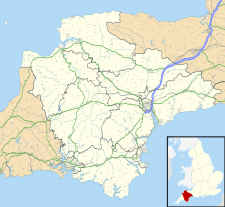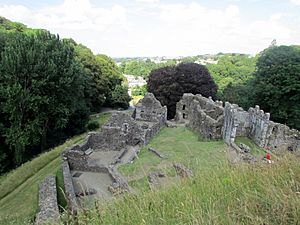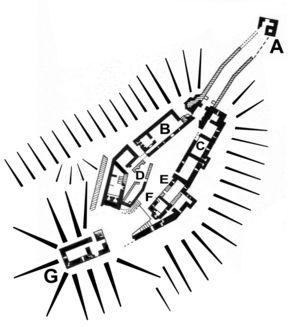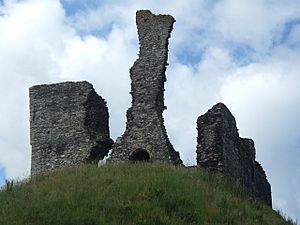Okehampton Castle facts for kids
Quick facts for kids Okehampton Castle |
|
|---|---|
| Okehampton, Devon, England | |
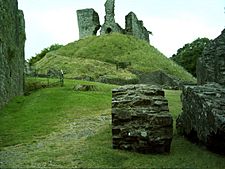
Keep of Okehampton Castle
|
|
| Coordinates | 50°43′50″N 4°00′31″W / 50.730515°N 4.008649°W |
| Type | Motte and bailey |
| Site information | |
| Owner | English Heritage |
| Open to the public |
Yes |
| Condition | Ruined |
| Site history | |
| Materials | Stone |
Okehampton Castle is a medieval castle found in Devon, England. It's a special type of castle called a motte and bailey. This means it has a large earth mound (the motte) with a tower on top. It also has a walled courtyard (the bailey) below.
The castle was built between 1068 and 1086 by a Norman lord named Baldwin FitzGilbert. This happened after a rebellion in Devon against the new Norman rulers. Okehampton Castle was the main base for a large area of land called the Honour of Okehampton. It also protected an important river crossing over the West Okement River.
Okehampton Castle was used for defence until the late 1200s. Its owners, the de Courtenay family, then became very rich and powerful. They were known as the Earls of Devon. With their new wealth, they changed the castle into a fancy hunting lodge.
They created a huge new deer park stretching south from the castle. They also built stylish new rooms with amazing views. The de Courtenay family grew even richer. The castle was made even bigger to fit their growing household.
In the 1400s, the de Courtenays were involved in the Wars of the Roses. This was a big civil war in England. Because of this, Okehampton Castle was often taken away from them. By the early 1500s, the castle was still in good shape.
But then, Henry Courtenay was executed by Henry VIII. After this, the castle was left empty and fell apart. The deer park was rented out by the King. In the 1600s, parts of the castle were even used as a bakery!
By the 1800s, the castle was a complete ruin. It became a popular spot for artists who liked painting old, romantic ruins. Famous painters like J. M. W. Turner visited it. Real repair work started in the 1900s. First, it was owned privately, then by the government.
Today, English Heritage looks after Okehampton Castle. It is a popular place for tourists to visit.
Contents
How Okehampton Castle Was Built
Building the Castle: 1066-1296
Okehampton Castle was built between 1068 and 1086. This was after the Norman conquest of England. William the Conqueror won the battle of Hastings in 1066. But fighting continued for several years after the invasion.
Baldwin FitzGilbert was a Norman lord. He was in charge of stopping a rebellion in Devon in 1068. He likely received a lot of land in the area. By 1086, he owned the Honour of Okehampton. He was also the Sheriff of Devon.
The Honour of Okehampton was a group of about 200 estates across Devon. Several castles protected these lands. Baldwin's main castle was at Okehampton. His tenants also owned castles like Neroche and Montacute.
Baldwin's castle was placed to protect an important route. This route went from Devon into Cornwall. It included two river crossings, or fords, over the West Okement River. The castle also controlled the nearby town of Ocmundtune.
The castle had a special system called castle-guard. Land was given to Baldwin's tenants. In return, they helped guard the castle. Baldwin also started a new town about 1 km away. It had a market and a mill for grinding grain. This new town became the main settlement and was called Okehampton.
When Baldwin died, his daughter Adeliza inherited the castle. But her family didn't seem very interested in it. Okehampton Castle didn't play a part in the civil war from 1139 to 1153. This war was known as the Anarchy.
In 1173, Okehampton Castle passed to Renaud de Courtenay through marriage. His son, Robert de Courtenay, married the daughter of the Earl of Devon. The castle was still useful for military purposes. Richard I used it from 1193 to 1194. This was to help defend Devon for the King.
The de Courtenay family did some building work at the castle. They added new structures in the castle's bailey. Robert was followed by his son John de Courtenay. By 1274, when John's son Hugh de Courtenay owned it, the castle was described as "an old motte which is worth nothing". It also had a "hall, chamber and kitchen poorly built". But this description might not have been entirely accurate.
From Defence to Luxury: 1297-1455
The Redvers family line ended in 1297. Because of this, Hugh's son, another Hugh de Courtenay, inherited their lands. He was later confirmed as the Earl of Devon. Hugh's main home was at Tiverton Castle.
However, Hugh and his father rebuilt Okehampton Castle. They added more rooms and facilities. This was so it could be used as a hunting lodge and a quiet retreat. A lot of building work turned the castle into a very fancy home.
As part of this project, the family created a huge new deer park. It replaced the older, open hunting areas. Deer parks were a sign of high status back then. Many nobles who gained power built similar parks.
Creating the park meant clearing away old settlements around the castle. It covered about 690 hectares (1700 acres) south of the castle. Fields and pastures were also abandoned. These old settlements had houses built during a warmer period. But they might have become harder to live in as the climate got colder in the late 1200s. Land near the castle, called Kennel Field, was used for the hunting dogs.
Once the deer park was ready, many fallow deer lived there. Wild boar, foxes, and hares were also hunted. People at Okehampton Castle ate a lot of venison (deer meat). This was a special, high-status food. Some venison came from the park. But the best cuts were brought in from other places.
Archaeological digs show that the castle also imported fish from the coast. This was over 40 km (25 miles) away! Hake, herring, plaice, and whiting were the most common types of fish eaten.
The Courtenays continued to own Okehampton for many years. The castle passed from Hugh to his son, another Hugh. Then it went to his grandson Edward. And then to his great-grandson, another Hugh de Courtenay.
Noble households grew larger during this time. By the 1380s, Edward's household could have up to 135 people. In the late 1300s and early 1400s, Okehampton Castle was made even bigger. This was likely to fit all these extra people.
Decline and Ruin: 1455-1900
In the 1400s, the Courtenay family got caught up in the Wars of the Roses. This was a civil war between two powerful families: the Lancastrians and the Yorkists. Thomas de Courtenay first fought for the Yorkists. But he later joined the Lancastrians.
His son, Thomas, died after being captured by the Yorkists in 1461. Edward IV took Okehampton Castle. But it was later given back to the family by the Lancastrian King Henry VI.
John Courtenay died fighting for the Lancastrians in 1471. The castle and the title of Earl were taken away again. But when Henry VII became king in 1485, the title and Okehampton were returned to Edward Courteney.
Edward's son, William, had a difficult political life. The castle was taken away again for a while. His son, Henry, was executed by Henry VIII in 1539. His properties were taken permanently. This ended the Courtenay family's link to the castle.
After Henry's death, a survey said the castle had "all manner of houses of offices". But from this time on, the castle seems to have been left to decay. Some of its lead and stonework were probably taken for other building projects. The castle's deer park was rented out by the King.
Owning the castle was still important, though. From 1623, owning it meant you could choose Okehampton's two Members of Parliament. Even though a battle was fought near Okehampton in 1643 during the English Civil War, the castle wasn't involved. A bakehouse was set up in the castle in the late 1600s. It used parts of the western rooms. The deer park became farmland again in the 1700s.
In the 1700s, the castle became a popular subject for painters. They were interested in the popular styles of the Picturesque. Richard Wilson painted the castle in 1771. He showed the keep dramatically against the sky. Thomas Girtin painted the castle in 1797, and his friend J. M. W. Turner in 1824. Sir Vyell Vyvyan made some small repairs to the castle in the 1800s.
Modern Times: 20th-21st Centuries
In the early 1900s, a local man named Sydney Simmons bought Okehampton Castle. Between 1911 and 1913, he cleared away the plants that had grown over the castle. He also made some repairs to the stone. Simmons gave the castle to the Okehampton Castle Trust in 1917. They did limited repairs over the next few decades.
The Ministry of Public and Works took over the site in 1967. A lot of restoration work was done after that. Major archaeological digs were carried out in the 1970s. Today, English Heritage manages the castle as a tourist attraction. It is protected by law as an ancient monument and a grade I listed building.
What Okehampton Castle Looks Like
Okehampton Castle was built on a long, thin rocky hill. This hill rose up from the land around it. The stream on the north side of the castle would have been bigger in medieval times. It gave extra protection on that side. The south side of the castle probably looked out over wet fields.
The castle was mostly built from local stone. This included aplite from nearby Meldon and some beerstone from south-east Devon. The inside and outside stone would have been covered with plaster. Visitors would have entered from the barbican in the north-east. They would walk up a long path into the bailey. On the south-west side of the bailey was the motte, with the keep on top.
The castle's design shows how it was changed in the early 1300s. It used two very different styles of architecture. From the north, where the main road passed, the castle looked like a strong military fort. It had narrow windows and tall defences.
But from the deer park on the south, the castle's living areas were on full display. They had low walls and large windows. The park was connected to the south side of the castle. From the big windows of the eastern rooms, you could look out over the park. You wouldn't see any signs of villages or the nearby town. It would have been a "stunning" view.
The barbican was built in the early 1300s. It had a guard-room on the first floor. A passage led from the barbican to the gatehouse. This gatehouse probably had a drawbridge. It also had rooms for the castle's constable.
By the 1300s, the castle bailey had many buildings. On the north side were the Great Hall, the buttery, and the kitchens. The Great Hall had a large, fancy window. Above the buttery was a luxurious apartment called a solar.
On the south side of the bailey were the western rooms. These were well-equipped for guests. They were built by filling in part of the ditch between the motte and the bailey. Later, these rooms were turned into a bakery. A chapel and rooms for the castle's chaplain were nearby. The chapel walls were painted with red lines to look like cut stone. Next to the chapel were the eastern rooms. Their design was similar to those at Tiverton Castle. This was another de Courtenay property built at the same time.
The motte, on the far side of the bailey, is mostly a natural rock outcrop. It was made stronger with earth from digging the castle ditches. It stands up to 32 metres (105 feet) high. The top measures 29.5 metres by 15.5 metres (97 by 51 feet). The motte is separated from the main castle by ditches. This is similar to the motte at Windsor Castle.
On top of the motte is the castle keep. It was first built in the 1000s. It had massive stone walls at least one storey high, maybe even three. It was rebuilt in the early 1300s as a two-storey building. It also had a rectangular addition on the west side. The 1000s parts of the keep used granite stone. This probably came from the West Okement river bed. The 1300s keep had two sets of rooms on the upper floor. These were similar to those in the bailey. It also had a turret with a staircase, some of which still remains.
The keep is unusual for its time and for Devon. It was a very strong defensive structure. But it didn't have its own water source or facilities to support soldiers during a siege. Other rectangular keeps from the 1000s existed in Devon. These were usually linked to the king or major nobles. Few were built on top of new mottes, like at Okehampton. This might have been possible here because the motte was mostly natural rock. This meant it could support the heavy weight.
A Ghost Story of Okehampton Castle
People say that the castle is haunted by the ghost of Lady Howard. She is said to have murdered three of her husbands and two of her children. An old song is sung about this ghost who haunts the castle: "My Ladye hath a sable coach, with horses two an four. My Ladye hath a gaunt blood-hound, that goeth before. My Ladye’s coach hath nodding plumes,the driver hath no head. My Ladye is an ashen white - as one who is long dead."
The lady is believed to be from the 1600s. She supposedly uses a coach made of her victims' bones. Her hound has only one eye. Her curse is to collect blades of grass in the castle ruins forever. Or she will find peace when she collects every single blade of grass from the castle ruins. No real historical person or event has been found to be the basis for this story.
Building Materials of the Castle
The area around the castle has different types of rock. These are typical for the region. You can find granite, volcanic rocks, and rocks from the Devonian period. These include metamorphic rocks, limestone, and shale or slate. Beerstone is a special type of limestone found here.
The oldest part of the castle is made of granite and metamorphic rock. The newer parts of the castle were built using different types of limestone, shale, and granite. Granite was used for fireplaces. Lead and slate were used for roofing.


